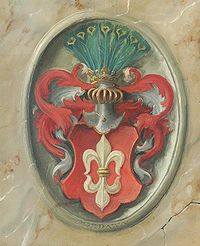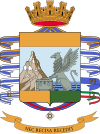Welcome to the Heraldry and Vexillology Portal!


Vexillology (from the Latin vexillum, a flag or banner) is the scholarly study of flags, including the creation and development of a body of knowledge about flags of all types, their forms and functions, and of scientific theories and principles based on that knowledge. Flags were originally used to assist military coordination on the battlefield, and have evolved into a general tool for signalling and identification, particularly identification of countries.
Heraldry encompasses all of the duties of a herald, including the science and art of designing, displaying, describing and recording coats of arms and badges, as well as the formal ceremonies and laws that regulate the use and inheritance of arms. The origins of heraldry lie in the medieval need to distinguish participants in battles or jousts, whose faces were hidden by steel helmets.
Selected biography

William Camden (May 2, 1551–November 9, 1623) was an English antiquarian and historian. He wrote Britannia, the first topographical survey of the island of Great Britain, and Annales, the first detailed historical account of the reign of Elizabeth I of England. In 1597 he was appointed Clarenceux King of Arms to facilitate his research, the post carrying a salary, and the College of Arms at the time being a centre of antiquarian studies. The appointment, however, roused the jealousy of the herald Ralph Brooke, who in retaliation published an attack on Britannia, charging Camden with inaccuracy and plagiarism. Camden successfully defended himself against the charges in subsequent editions of the work. (more...)
Selected flag

The flag of the Republic of China, commonly known as Taiwan, was first used in mainland China by the Kuomintang (KMT, Chinese Nationalist Party) in 1917 and was made the official flag of the ROC in 1928. It was enshrined in the 6th article of the Constitution of the Republic of China when it was promulgated in 1947. Since 1949, the flag is mostly used within Taiwan where the Republic of China relocated after having lost the Chinese Civil War to the People's Republic of China.
In Chinese, the flag is commonly described as Blue Sky, White Sun, and a Wholly Red Earth (traditional Chinese: 青天, 白日, 滿地紅; simplified Chinese: 青天, 白日, 满地红; pinyin: Qīng Tiān, Bái Rì, Mǎn Dì Hóng) to reflect its attributes. The canton (upper corner on the hoist side) originated from the "Blue Sky with a White Sun flag" proposed by Lu Hao-tung in 1895 and adopted as the KMT party flag. The "red earth" portion was added by Sun Yat-sen in 1906. After the Republican revolution, the provisional Senate selected the "Five-Colored Flag" as the national flag in 1912. After President Yuan Shikai suppressed the KMT, Sun Yat-sen established a government-in-exile in Tokyo and eventually a rival government in Guangzhou in 1917, using the KMT flag as the national ROC flag. This flag was made the official national flag on December 17, 1928 after the Northern Expedition toppled the Beiyang government. (more...)
Selected coat of arms

The seal of Indiana is used by the Governor of Indiana to certify official documents. The seal has gone through several revisions since the region was a part of the Northwest Territory. It is likely the original seal, which is similar to the current one, was created by William Henry Harrison during his administration of the Indiana Territory. The current design of the seal was standardized by the Indiana General Assembly in 1963.
The sun rising in the picture represents that Indiana has a bright future ahead and is just beginning. The mountains it rises over are a representation of the Allegheny Mountains showing that Indiana is in the west. The woodman represents civilization subduing the wilderness that was Indiana. The buffalo represents the wilderness fleeing westward away from the advancing civilization. (more...)
Selected picture

Oil painting (2005) of the Coat of arms of Gozdawa. In Polish heraldry each coat of arms has its own name and may be shared by several unrelated families.
Did you know...
- ...that the Italian mountain Cimon della Pala appears on the coat of arms of the Guardia di Finanza (pictured)?
- ...that Charles St Clair, 17th Lord Sinclair was both York Herald and a Scottish Peer, so he could attend the State Opening of Parliament in either capacity?
- ...that the Dering Roll begins with the coats of arms of two illegitimate sons of King John of England?
- ...that the Guilford Courthouse flag is the oldest surviving example of an American flag with eight-pointed stars?
- ...that for the filming of Max Manus in 2008, the flag of Nazi Germany was flown from the roof of the Norwegian parliament building for the first time in over 60 years?
Related portals
Major topics and navigation
|
|
|
Heraldry Web resources
Authorities
- Belgium - The Council of Nobility, Flemish Heraldic Council and Council of Heraldry and Vexillology of the French Community
- Canada - Canadian Heraldic Authority and see also Public Register of Arms, Flags and Badges
- England, Wales, and Northern Ireland - The College of Arms
- Ireland - The Office of the Chief Herald of Ireland
- Netherlands - High Council of Nobility
- Portugal - Instituto da Nobreza Portuguesa
- Scotland - The Court of the Lord Lyon
- South Africa - South African Bureau of Heraldry
- Sweden - National Board of Heraldry, The National Archive
- United States Army - The United States Army Institute of Heraldry
Societies
- Greek Heraldry Society
- The Academy of Heraldic Science Czech republic
- The American College of Heraldry
- The American Heraldry Society
- The Augustan Society
- The Australian Heraldry Society Inc.
- Bulgarian Heraldry and Vexillology Society
- The Center for Research of Orthodox Monarchism
- Cambridge University Heraldic and Genealogical Society
- Chiltern Heraldry Group
- The College of Dracology
- Croatian Heraldic and Vexillologic Association
- The Finnish Heraldic Society
- Fryske Rie foar Heraldyk
- Hellenic Armigers Society
- Guild of Heraldic Artists
- Genealogical Society of Ireland
- Heraldry Research Institute (Japan)
- The Heraldry Society
- The Heraldry Society of Africa
- The Heraldry Society of New Zealand Inc.
- The Heraldry Society of Scotland
- The Heraldry Society of Southern Africa
- The Institute of Heraldic and Genealogical Studies
- The International Association of Amateur Heralds
- Italian Center of Vexillological Studies
- Lancashire Heraldry Group
- Macedonian Heraldry Society
- New England Historic Genealogical Society Committee on Heraldry
- Norwegian Heraldry Society
- Oxford University Heraldry Society
- Polish Heraldry Society
- Polish Nobility Confederation
- Real Academia Matritense de Heráldica y Genealogía - Royal Academy of Heraldry and Genealogy of Madrid
- Romanian Institute for Genealogy and Heraldry
- The Royal Heraldry Society of Canada
- The Russian College of HeraldryThe Russian College of Heraldry
- Serbian Heraldic Society
- Societas Heraldica Scandinavica
- Societas Heraldica Slovenica
- Swedish Heraldic Society
- Ukrainian Heraldry Society
- Royal Association Genealogical and Heraldic Office of Belgium
Vexillology
Software
- Coat of Arms Visual Designer web-based program
- Puncher Heraldry Program
- Blazonry Server - pyBlazon
- DrawShield - creates SVG shield or arms image from blazon
- CoaMaker - web-based tool
- Blazon95 and BLAZONS! 2000, older Windows applications
Texts
- Heraldry, historical and popular : with seven hundred illustrations (1863)
- A Complete Guide to Heraldry (1909)
Other
Wikimedia
The following Wikimedia Foundation sister projects provide more on this subject:
-
Commons
Free media repository -
Wikibooks
Free textbooks and manuals -
Wikidata
Free knowledge base -
Wikinews
Free-content news -
Wikiquote
Collection of quotations -
Wikisource
Free-content library -
Wikispecies
Directory of species -
Wikiversity
Free learning tools -
Wikivoyage
Free travel guide -
Wiktionary
Dictionary and thesaurus











